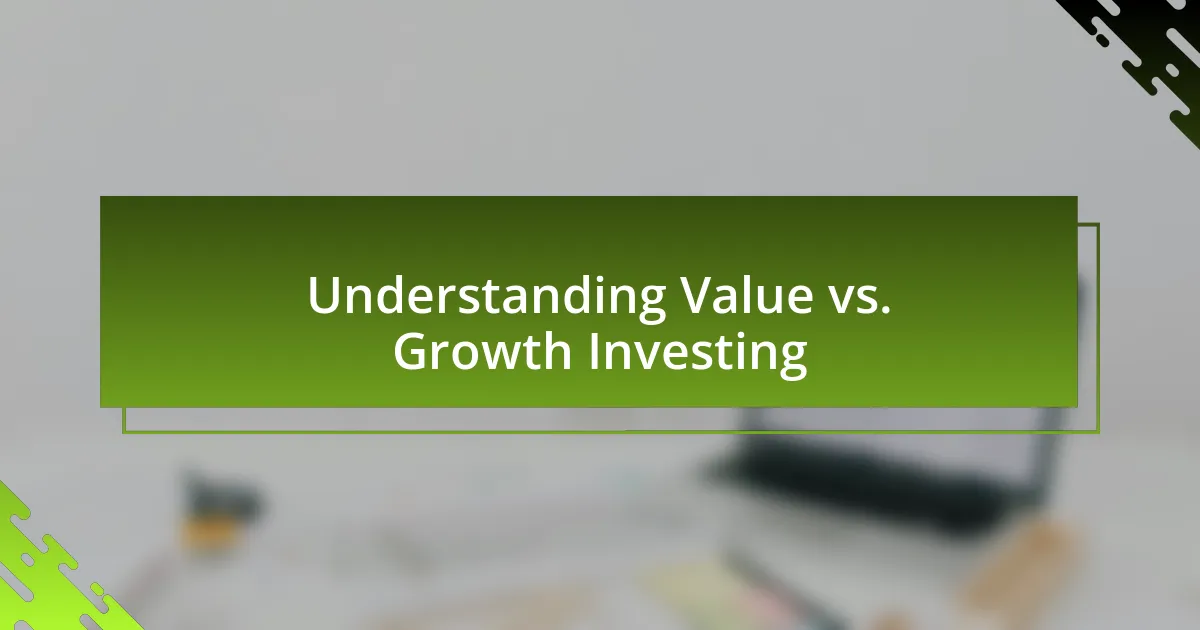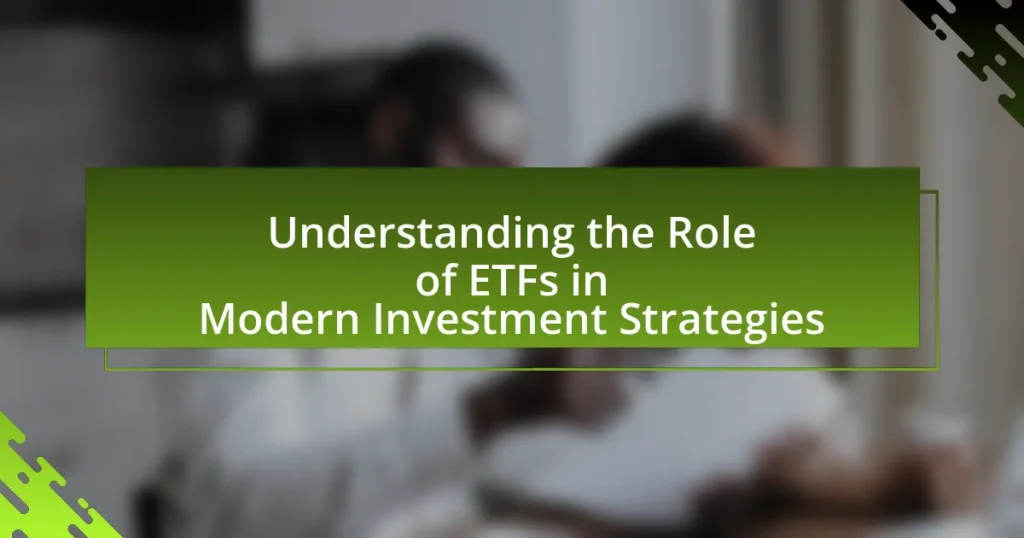Value vs. Growth Investing refers to two distinct investment strategies that guide investors in selecting stocks based on their perceived worth and growth potential. Value investing emphasizes purchasing undervalued stocks believed to be trading below their intrinsic value, focusing on financial metrics such as price-to-earnings ratios and strong fundamentals. Conversely, growth investing targets companies expected to grow at an above-average rate, prioritizing revenue and earnings growth, often reflected in higher price-to-earnings ratios. The article explores the defining characteristics, key metrics, and historical performance of both strategies, highlighting their implications for investment decisions and the influence of market conditions. Additionally, it discusses how personal financial goals and risk tolerance affect the choice between these investment styles, along with strategies for effectively balancing both approaches in a diversified portfolio.
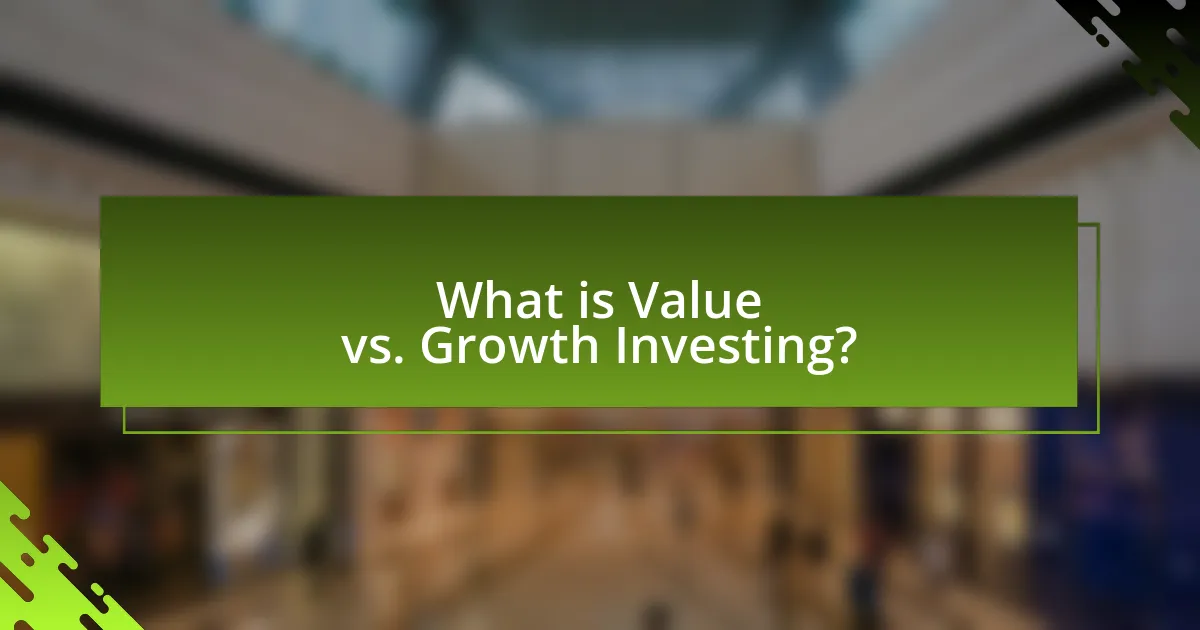
What is Value vs. Growth Investing?
Value investing focuses on purchasing undervalued stocks that are believed to be trading for less than their intrinsic value, often identified through financial metrics like price-to-earnings ratios. In contrast, growth investing targets companies expected to grow at an above-average rate compared to their industry or the overall market, often prioritizing revenue and earnings growth over current valuation metrics. Historical data shows that value stocks have outperformed growth stocks over long periods, as evidenced by the Fama-French research, which indicates that value investing strategies yield higher returns than growth strategies in the long run.
How do Value and Growth Investing differ?
Value investing focuses on purchasing undervalued stocks that are believed to be trading for less than their intrinsic value, while growth investing targets stocks expected to grow at an above-average rate compared to their industry or the overall market. Value investors often look for companies with low price-to-earnings ratios and strong fundamentals, whereas growth investors prioritize companies with high earnings growth potential, even if their current valuations appear high. Historical data shows that value stocks have outperformed growth stocks over long periods, as evidenced by the Fama-French research, which indicates that value investing yields higher returns than growth investing on average.
What are the defining characteristics of Value Investing?
Value investing is characterized by the purchase of undervalued stocks that are believed to be trading for less than their intrinsic value. Investors in this strategy focus on fundamental analysis, assessing a company’s financial health, earnings potential, and market position to identify stocks that are undervalued relative to their true worth. A key characteristic is the emphasis on a margin of safety, which protects investors from significant losses by ensuring that the purchase price is substantially lower than the estimated intrinsic value. Historical evidence shows that value investing has outperformed growth investing over long periods, as demonstrated by studies from financial institutions like Dimensional Fund Advisors, which highlight the long-term returns of value stocks compared to growth stocks.
What are the defining characteristics of Growth Investing?
Growth investing is characterized by the focus on companies expected to grow at an above-average rate compared to their industry or the overall market. This investment strategy prioritizes stocks of businesses that exhibit strong revenue and earnings growth potential, often reinvesting profits to fuel further expansion rather than paying dividends.
Key characteristics include a high price-to-earnings (P/E) ratio, indicating that investors are willing to pay a premium for anticipated growth, and a strong emphasis on innovation and market leadership. Historical data shows that growth stocks have outperformed value stocks over long periods, particularly in bull markets, as evidenced by the performance of indices like the NASDAQ, which is heavily weighted towards growth companies.
Why is understanding these investment styles important?
Understanding investment styles, such as value and growth investing, is crucial because it enables investors to align their strategies with their financial goals and risk tolerance. By recognizing the characteristics of each style, investors can make informed decisions that optimize their portfolio performance. For instance, historical data shows that value stocks have outperformed growth stocks over long periods, particularly during market downturns, as evidenced by the Fama-French research which highlights the value premium. This understanding allows investors to strategically allocate resources, manage risks, and capitalize on market opportunities effectively.
How can these styles impact investment decisions?
Value and growth investing styles significantly impact investment decisions by influencing the selection of stocks based on their perceived worth and growth potential. Investors who favor value investing typically seek undervalued stocks with strong fundamentals, believing that the market will eventually recognize their true value, which can lead to substantial returns. Conversely, growth investors prioritize companies with high growth rates, often accepting higher valuations in anticipation of future earnings expansion.
Research indicates that value stocks have historically outperformed growth stocks over long periods, as evidenced by the Fama-French three-factor model, which highlights the value premium. This historical performance can guide investors in their asset allocation strategies, affecting portfolio construction and risk management. Therefore, understanding these styles helps investors align their strategies with their financial goals and market conditions.
What role do market conditions play in choosing an investment style?
Market conditions significantly influence the choice of investment style, as they determine the performance of value and growth stocks. In bullish markets, growth investing tends to outperform due to increased investor confidence and higher earnings expectations, leading to elevated stock prices. Conversely, in bearish or uncertain market conditions, value investing often prevails, as investors seek stability and undervalued assets that can provide better downside protection. Historical data shows that during the 2000 dot-com bubble burst, value stocks outperformed growth stocks, highlighting how market conditions can dictate investment strategies.
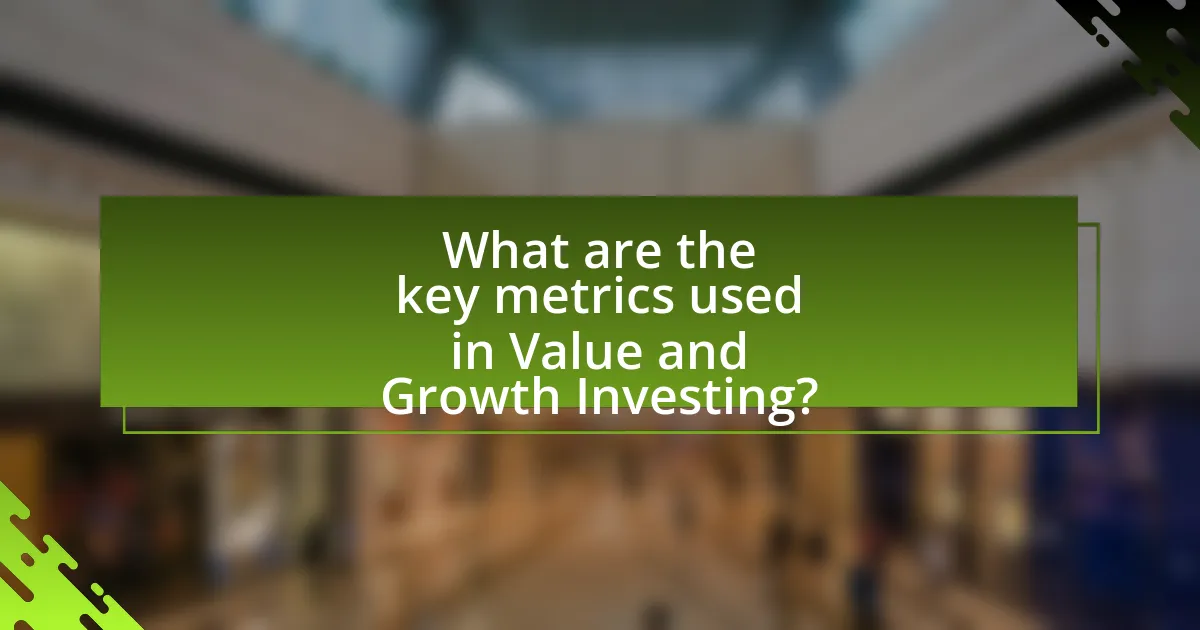
What are the key metrics used in Value and Growth Investing?
The key metrics used in Value Investing include Price-to-Earnings (P/E) ratio, Price-to-Book (P/B) ratio, Dividend Yield, and Earnings Per Share (EPS). These metrics help investors identify undervalued stocks by comparing a company’s market price to its intrinsic value. For instance, a low P/E ratio may indicate that a stock is undervalued relative to its earnings, while a high Dividend Yield suggests a strong return on investment through dividends.
In contrast, Growth Investing focuses on metrics such as Earnings Growth Rate, Price-to-Earnings Growth (PEG) ratio, and Revenue Growth. These metrics assess a company’s potential for future growth rather than its current valuation. For example, a high Earnings Growth Rate indicates strong future earnings potential, while a PEG ratio below 1 suggests that a stock may be undervalued relative to its growth rate.
Both investing styles utilize these metrics to guide investment decisions, with Value Investing emphasizing current valuation and Growth Investing prioritizing future growth potential.
What financial ratios are essential for Value Investing?
The essential financial ratios for value investing include the Price-to-Earnings (P/E) ratio, Price-to-Book (P/B) ratio, Dividend Yield, and Debt-to-Equity (D/E) ratio. The P/E ratio helps investors assess a company’s valuation relative to its earnings, with a lower P/E often indicating undervaluation. The P/B ratio compares a company’s market value to its book value, signaling potential investment opportunities when the ratio is below 1. Dividend Yield provides insight into the income generated from investments, with higher yields attracting value investors. Lastly, the D/E ratio evaluates a company’s financial leverage, with lower ratios generally indicating a more stable investment. These ratios are critical in identifying undervalued stocks that have the potential for long-term growth.
How do Price-to-Earnings (P/E) ratios influence Value Investing?
Price-to-Earnings (P/E) ratios significantly influence value investing by helping investors assess whether a stock is undervalued or overvalued relative to its earnings. Value investors typically seek stocks with low P/E ratios, as these may indicate that the stock is trading at a discount compared to its intrinsic value. For instance, a P/E ratio lower than the industry average can signal a potential buying opportunity, suggesting that the market has not fully recognized the company’s earnings potential. Historical data shows that value stocks, often characterized by lower P/E ratios, have outperformed growth stocks over long investment horizons, reinforcing the importance of P/E ratios in identifying investment opportunities.
What is the significance of Price-to-Book (P/B) ratios in Value Investing?
The Price-to-Book (P/B) ratio is significant in value investing as it helps investors assess whether a stock is undervalued or overvalued relative to its book value. A P/B ratio below 1 often indicates that the stock may be undervalued, suggesting a potential buying opportunity for value investors who seek to purchase stocks at a discount to their intrinsic value. For instance, historical data shows that companies with low P/B ratios tend to outperform the market over time, as they often represent firms with solid fundamentals that the market has overlooked. This relationship between low P/B ratios and potential investment returns reinforces the importance of the P/B ratio in identifying value stocks.
What metrics are crucial for evaluating Growth Investing?
The crucial metrics for evaluating Growth Investing include revenue growth rate, earnings per share (EPS) growth, price-to-earnings (P/E) ratio, and return on equity (ROE). Revenue growth rate indicates how quickly a company is expanding its sales, which is essential for growth investors seeking companies with strong sales momentum. Earnings per share growth reflects a company’s profitability and its ability to generate increasing earnings over time, a key factor for assessing future performance. The price-to-earnings ratio helps investors determine if a stock is overvalued or undervalued relative to its earnings, providing insight into market expectations. Return on equity measures how effectively a company uses shareholders’ equity to generate profits, indicating operational efficiency. These metrics collectively provide a comprehensive view of a company’s growth potential and financial health, essential for making informed investment decisions in the growth investing space.
How does Earnings Growth Rate affect Growth Investing decisions?
Earnings Growth Rate significantly influences Growth Investing decisions by serving as a primary indicator of a company’s potential for future expansion. Investors prioritize companies with high earnings growth rates because these firms are often perceived as having strong business models and competitive advantages, which can lead to substantial returns. For instance, a study by Fidelity Investments found that companies with earnings growth rates exceeding 15% typically outperform the market, highlighting the correlation between growth rates and investment performance. Consequently, a higher earnings growth rate can lead to increased investor interest, driving up stock prices and enhancing overall portfolio value.
What is the importance of Price-to-Earnings Growth (PEG) ratio in Growth Investing?
The Price-to-Earnings Growth (PEG) ratio is crucial in growth investing as it provides a more comprehensive valuation metric than the Price-to-Earnings (P/E) ratio alone. The PEG ratio accounts for a company’s expected earnings growth rate, allowing investors to assess whether a stock is overvalued or undervalued relative to its growth potential. For instance, a PEG ratio of 1 suggests that the stock’s price is in line with its growth expectations, while a ratio above 1 may indicate overvaluation, and below 1 may suggest undervaluation. This metric is particularly important in growth investing, where companies often have high P/E ratios due to anticipated future growth. By incorporating growth expectations, the PEG ratio helps investors make more informed decisions, aligning their investments with companies that are not only growing but are also reasonably priced based on that growth.
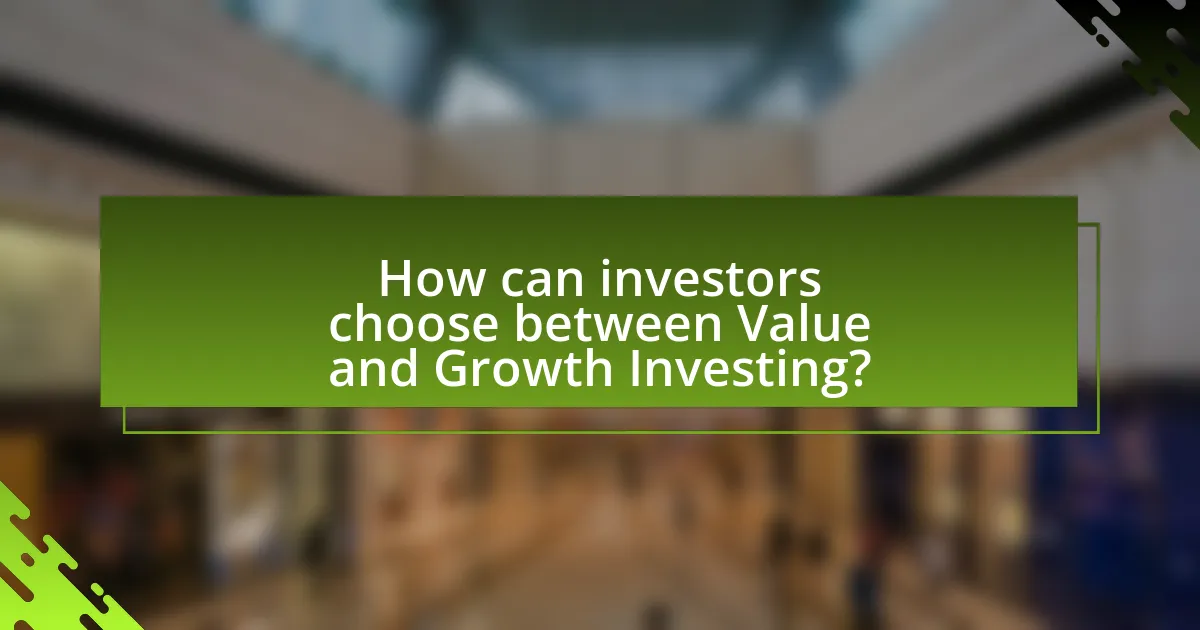
How can investors choose between Value and Growth Investing?
Investors can choose between Value and Growth Investing by assessing their risk tolerance, investment horizon, and market conditions. Value Investing focuses on undervalued stocks with strong fundamentals, often trading below their intrinsic value, while Growth Investing targets companies expected to grow at an above-average rate, even if their current valuations are high. Historical data shows that Value stocks have outperformed Growth stocks over long periods, particularly during market downturns, as evidenced by the Fama-French research which indicates that Value stocks have provided higher returns than Growth stocks over the last several decades. Therefore, investors should align their choice with their financial goals and market outlook.
What factors should investors consider when selecting an investment style?
Investors should consider their risk tolerance, investment horizon, and market conditions when selecting an investment style. Risk tolerance determines how much volatility an investor can withstand, influencing whether they lean towards value investing, which typically involves less risk, or growth investing, which can be more volatile but offers higher potential returns. The investment horizon is crucial as value investing often requires a longer time frame to realize gains, while growth investing may appeal to those looking for quicker returns. Market conditions also play a significant role; for instance, in a bull market, growth stocks may outperform, whereas value stocks might be more favorable in a bear market. These factors collectively guide investors in aligning their investment style with their financial goals and market dynamics.
How do personal financial goals influence the choice between Value and Growth Investing?
Personal financial goals significantly influence the choice between Value and Growth Investing by determining the investor’s risk tolerance and time horizon. Investors focused on long-term wealth accumulation may prefer Growth Investing, which targets companies expected to grow at an above-average rate, potentially yielding higher returns over time. Conversely, those prioritizing immediate income or capital preservation may lean towards Value Investing, which seeks undervalued stocks that provide dividends and stable returns. Research indicates that investors with a shorter time frame often favor Value stocks, as they tend to be less volatile and provide more immediate financial benefits, while those with a longer horizon are more likely to invest in Growth stocks, anticipating substantial appreciation in value.
What is the impact of risk tolerance on investment style selection?
Risk tolerance significantly influences investment style selection by determining whether an investor prefers value or growth investing. Investors with high risk tolerance are more likely to favor growth investing, which typically involves higher volatility and potential for substantial returns, as evidenced by historical data showing that growth stocks have outperformed value stocks during bull markets. Conversely, those with low risk tolerance tend to gravitate towards value investing, which focuses on stable, undervalued companies with lower volatility and consistent dividends, aligning with their preference for capital preservation. This relationship is supported by studies indicating that risk-averse investors prioritize steady returns over high-risk opportunities, thereby shaping their investment choices.
What strategies can investors employ to balance Value and Growth Investing?
Investors can balance Value and Growth Investing by employing a diversified portfolio strategy that includes both asset types. This approach allows investors to capture the potential upside of growth stocks while benefiting from the stability and income generation of value stocks. For instance, research by Morningstar indicates that a balanced allocation of 60% in value stocks and 40% in growth stocks can optimize returns while mitigating risks associated with market volatility. Additionally, investors can utilize a sector rotation strategy, shifting investments between value and growth sectors based on economic cycles, which has historically proven effective in maximizing returns during different market conditions.
How can diversification enhance investment outcomes in Value and Growth Investing?
Diversification enhances investment outcomes in Value and Growth Investing by reducing risk and improving potential returns. By spreading investments across various sectors and asset classes, investors can mitigate the impact of poor performance in any single investment. For instance, during market downturns, value stocks may perform better than growth stocks, and vice versa during market upswings. Historical data shows that a diversified portfolio can lead to more stable returns over time, as evidenced by studies indicating that diversified portfolios tend to outperform concentrated ones in terms of risk-adjusted returns. This strategic allocation allows investors to capture gains from different market conditions while minimizing volatility.
What are some best practices for combining both investment styles effectively?
To effectively combine value and growth investing styles, investors should diversify their portfolios by allocating a portion to undervalued stocks while also investing in high-growth companies. This strategy allows for capitalizing on the stability and income potential of value stocks, which typically have lower volatility, alongside the higher return potential of growth stocks, which can drive significant capital appreciation. Historical data shows that during market downturns, value stocks often outperform growth stocks, while growth stocks tend to excel in bull markets. By balancing these two styles, investors can mitigate risks and enhance overall portfolio performance, as evidenced by studies indicating that a blended approach can yield better risk-adjusted returns over time.
